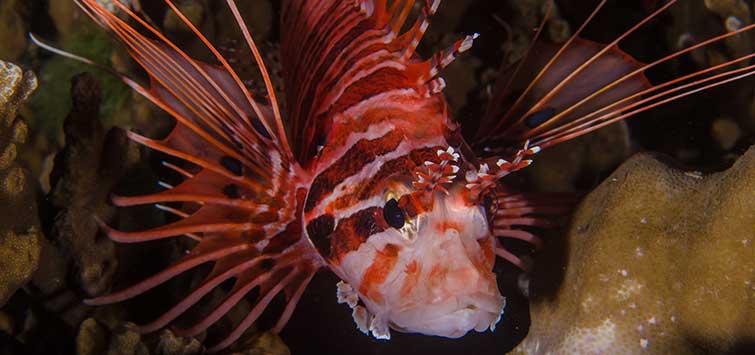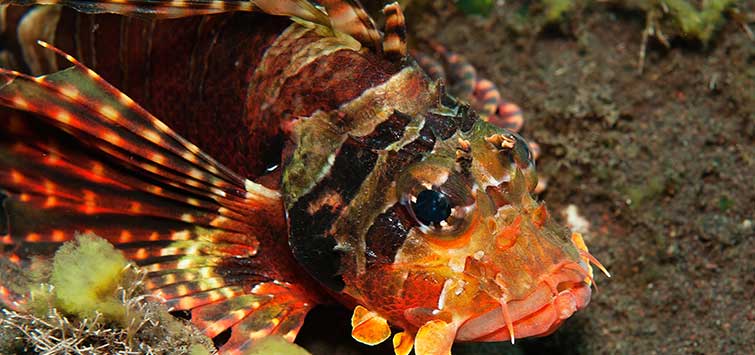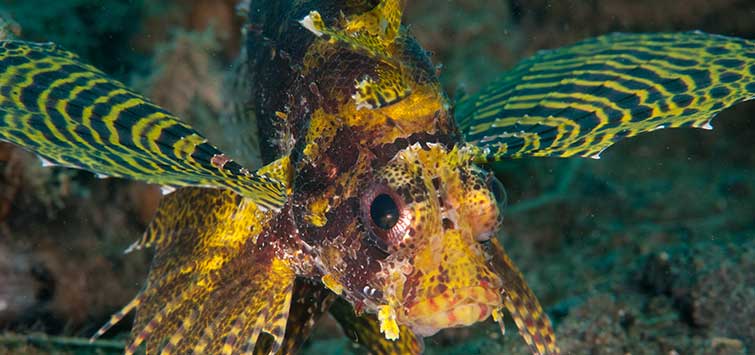Stings of the Scorpaenids
Author: James W. Fatherree, MSc
One of the traits that make lionfish and other scorpaenids seem so exotic is their venomous spines, but before obtaining these dangerous fish, aquarists should know how to prevent and treat their stings.
Not-So-Cowardly Lionfishes
The lionfishes, also often known as turkeyfishes or zebrafishes, are definitely some of the most popular marine fishes around. You can find them in just about any saltwater fish shop, and they’re well known among non-hobbyists, too, as they have quite a memorable appearance. But these members of the family Scorpaenidae are well known for more than just their good looks—they also have the ability to strike an unlucky victim with venom-delivering spines.
The fact that lionfishes are readily available and regularly taken home makes the potential for hobbyists to get injured by one a real possibility. So it’s a good idea to be aware of the common causes and effects of a sting (properly called an envenomation), and what you should do if it ever happens to you. Fortunately, while there are stories of lionfish stings actually leading to someone’s death, the truth is far less exciting. To the contrary, a mortal wound is much more likely to come from one of their less-conspicuous cousins, which I’ll also tell you a little about.
The Family Scorpaenidae
Venom
All of the fishes that belong to the family Scorpaenidae are venomous. They can be split up into three general groups, each of which delivers venom of differing quantity and potency. Lionfishes (species of Pterois, for example) are known for typically having long, relatively slender spines; they also have the smallest venom glands and produce the weakest venom. The scorpionfishes (Scorpaena species) have shorter but sturdier spines and larger venom glands compared to the lionfishes, thus they have the potential to deliver a more potent sting. And then there are the stonefishes (Synanceia species, for example), which are the truly hard hitters. Armed with even shorter and stronger spines, they have the largest venom glands and can deliver a much larger dose of far more powerful venom.
Physical Appearance
Lionfishes vary in adult size from about 4 inches (as with the Fu-Manchu lionfish Dendrochirus biocellatus) up to 15 inches (the volitans lionfish Pterois volitans, for example) and are voracious predators that feed on everything from small shrimps to surprisingly large fishes. They typically have 12 to 13 elongated dorsal spines, and also two pelvic spines and three anal spines, all of which have a pair of venom glands at their bases. However, the fan-like arrays of pectoral fins that make them look so flamboyant are not equipped with these glands.
While these ornate, free-swimming lionfishes are typically easy to spot, the scorpionfishes and stonefishes typically are not. Those fishes tend to have exceptionally well-camouflaged bodies, and they spend pretty much all of their time sitting motionless on the seafloor. They’re ambush predators by nature, hanging around somewhere until an unwary prey item gets a bit too close. With this in mind, it should be no surprise that essentially all envenomations by scorpionfish and stonefish come by way of accidentally stepping on one that wasn’t seen, rather than as the result of an aggressive attack. Both of these types of scorpaenids are scarcely seen in shops, though, and I don’t know of anyone that walks around in their aquarium, either. So these two groups of fishes are not the main concern here.
The Envenomation
Stings from lionfishes are a defensive response, typically only occurring when a fish is cornered or harassed in some way. Lionfishes can charge at an adversary at surprising speed, considering their less-than-hydrodynamic appearance, and they usually wield their dorsal spines like so many tiny lances in a joust. And, as you’d probably guess, if this is going to happen it will most likely be during tank maintenance, as that’s the time when your attention may move away from the fish and to the task at hand.
A Running Start
While most fishes will typically move away from a scrubbing arm, the lionfishes have a habit of only occasionally moving away—just enough to get a running start back at the arm. I’ve been stung in this way, and I’ll tell you that it happened in the blink of an eye. So watch what you’re doing and don’t assume that a fish you’ve had for a while has somehow turned “tame,” as the foot-long individual that stung me had been in an aquarium under my care for at least two years with no problems. For whatever reason, it was “spooked” that day and reminded me that I shouldn’t be so careless as to ignore it. Of course, the other common way to get stung is to attempt to handle a lionfish during transportation, introduction, or relocation.
The Sting
The mechanism of the sting is actually rather simple. Each spine is covered with a sheath-like cover of thin flesh from its tip to its base, which is compressed down the spine when it is thrust into a victim’s flesh. The venom glands are positioned at the base of the spine in such a way that when the sheath is compressed downward, the glands are basically squeezed from above, releasing their product. The venom then travels through thin grooves in the spine and is delivered into the puncture wound it creates. As I understand, the harder the strike, the deeper the wound, the more compression, and the more venom injected. So, light strikes can be far less injurious than hard ones. Note that the venom delivered is variable in toxicity among different types of lionfishes; however, in all species, the venom produced is composed of thermolabile proteins that are sensitive to heat.
Broken Spines
Another dangerous aspect of a strike is the potential to have one or more spines broken off in your finger, hand, etc. Recall that the spines of the lionfishes are relatively long and thin, thus sections can be snapped off should you jerk away from an attacking fish at the moment of insertion. While the venom may initially be the only concern, a piece of spine left in a wound may actually be far more detrimental to your health in the long run.
The Effects of an Envenomation
Again, while stories of death by lionfish sting are rather common, it has been impossible for me to find a single documented case of anyone actually dying from one, even after an extensive search of medical literature. Other authors in the literature have reported the same thing, too. This does not mean that it has never happened, but it implies that death by lionfish sting is exceptionally rare if it ever does happen. In fact, it would likely be limited only to those victims that might display some sort of allergic reaction to a sting, or to those that later suffer from a fatal infection related to the wound.
Common Effects of a Sting
Conversely, in the vast majority of cases, the predominant effects of a sting are nothing more than severe pain and swelling in the area around the puncture. A handful of victims have experienced systemic symptoms like nausea, dizziness, muscle weakness, shortness of breath, and headache brought on by the venom and/or as a reaction to the level of pain, but that’s about it. In the worst of cases, when medical treatment has been administered, some blistering and/or tissue loss (necrosis) has been experienced in the wound area, but this is very rare.
For example, in a series of 101 documented cases of captive lionfish envenomations here in the United States, the following effects were reported by Gallagher (2001): 92 percent of patients experienced local pain, 60 percent of patients experienced swelling, 13 percent of patients experienced systemic symptoms, 1 percent of patients experienced tissue necrosis, and no patients died.
In another study of 45 documented cases of captive lionfish envenomations reported to the San Francisco Poison Control Center over a 5-year period, the following effects were reported by Kizer, et al. (1985): 100 percent of patients experienced local pain, 22 percent of patients experienced pain extending through the affected extremity, 13 percent of patients experienced systemic symptoms, and again, no patients died.
So it’s clear to see that that the odds of being seriously injured by a lionfish, while not null, are certainly slim if the wound is treated properly.
What to Do If Stung
Get Help
There are several things to do if you get stung by a lionfish, one of which is to get professional help. I realize I’ve just pointed out that the chances of receiving a serious injury are slim, but that’s if a sting is treated properly. Avoiding professional help or neglecting such an injury can be very painful and can lead to real trouble. Applying first-aid can help to relieve the pain almost immediately, but a trip to the emergency room should follow.
Carefully Remove Spine in Wound
As far as first-aid goes, you should check to see if there are any obvious pieces of spine left in the wound. If any are present, and can be easily removed, do so with great care. Sometimes it may be too painful an ordeal to remove pieces yourself, thus you may need to wait until a medical professional can take care of it.
The pieces are best removed using tweezers and a microscope anyway, and I’d bet that if you get stung it will happen to be your dominant hand. Left-handed home surgery (or right for the lefties) sounds like a bad idea to me. Likewise, special care should also be taken if a piece is embedded near a larger blood vessel, a joint, or a major nerve, etc., in which case you can compound the problem by attempting to do it yourself.
Apply Pressure to Stop Bleeding
In the event that the wound bleeds, apply direct pressure to help stop the flow. Of course you may have to pass over this procedure if you believe you might have a piece of spine left behind. It’s obviously better to bleed a bit than to unintentionally force a piece of spine further into your flesh.
Hot Water Therapy
Next is hot-water therapy. The venom is broken down very effectively by exposure to heat, thus you can soak or bathe the injured body part in water that is as hot as you can stand. This is normally around 110° to 115°F—don’t make it any hotter, though, as you’d risk scalding yourself and making matters worse.
Get to a Hospital
The sooner you can get to a hospital the better, so that treatment can continue. Upon arrival it’s important to report exactly what kind of fish has stung you. You should not assume that every doctor knows what a lionfish is, so explain if necessary. Once under their care, you will likely receive a continuing hot-water treatment for 30 to 90 minutes, and may get a shot of anesthetic if the pain is still severe.
Some doctors have suggested the use of a long-lasting painkiller, like Bupivacaine, as it can be used to deaden a wound area for hours. However, in the study of 101 cases summarized above, 97 percent of patients were relieved of pain by using the hot-water treatment only. Either way, once the initial treatment is complete, if needed, the wound should be elevated to help reduce any swelling.
While you may play surgeon and try to remove any pieces of spine yourself, it is absolutely imperative to make sure that any and all material is cleared from the wound to help prevent any sort of infection. Thus it’s highly recommended that the area be thoroughly checked using standard x-ray techniques, ultrasound, or even a CT or MRI scan. While that might seem excessive, keep in mind that the subsequent infection of a wound can oftentimes be far worse than the wound itself, and that leaving even a tiny piece of a fish under the skin is a good way to get infected.
Get a Tetanus Prophylaxis Shot
Lastly, in all cases where a skin-breaking wound is caused by a marine organism, tetanus prophylaxis (like a shot) is required if you’re not already up to date. It’s well documented that tetanus has caused deaths following marine-organism-related penetrating wounds, and numerous other infections can also occur in conjunction with such wounds, including Vibrio in rare cases. So, I can’t say it enough—be mindful of the possibility of these aftereffects of a sting. Because the potential for these is so high, doctors may also use various antibiotics as part of treatment, especially if an infection appears some time after the initial injury occurred.
Additional Info
As far as scorpionfish and stonefish encounters go, severe injuries are typical, but deaths are very uncommon. And, in some reports, death did not occur until many days or even weeks after the initial injury, leading to the belief that these fatalities were more likely the result of complications arising from infection of the wound. In one well-documented medical-literature report of death due to stonefish envenomation, it is believed that the venom was injected directly into a larger blood vessel, and thus was able to spread rapidly throughout the victim’s body (Gallagher, 2001). But, in general, chances for survival are good when medical treatment is provided, even in the worst cases.
To finish, if you are a diver and you should happen to get stung while down, don’t get the bends trying to surface too quickly. You’ll likely be much better off taking your time surfacing and then dealing with the wound, rather than being placed in a decompression chamber and having to deal with the wound inside. Always remember that if you fear that you may be suffering from symptoms of decompression-related sickness, you must make medical personnel aware of this immediately, regardless of the intensity of pain caused by a sting.
References
Gallagher, S. A. 2001. “Lionfish and Stonefish.” eMedicine Journal 2(7).
Garyfallou, G. T. and J. F. Madden. 1996. “Lionfish envenomation.” Annals of Emergency Medicine 28(4):456–457.
Guenin, D. G. and P. S. Auerbach. 1996. “Trauma and envenomations from the marine fauna.” In: Emergency Medicine: A Comprehensive Study Guide, 4th edition. Tintinalli, J. E., E. Ruiz, and R. L. Krome, eds. McGraw-Hill. New York, NY. pp. 868–873.
Kizer, K. W., H. E. McKinney, and P. S. Auerbach. 1985. “Scorpaenidae envenomation: A five-year poison center experience.” JAMA 253:807–810.
Otten, E. J. 1998. Venomous animal injuries, in Emergency Medicine: Concepts and Clinical Practice, 4th edition. Rosen, P., editor. Mosby Year Book. St. Louis, MO. pp. 924–932.
Patel, M. R. and S. Wells. 1993. “Lionfish envenomation of the hand.” Journal of Hand Surgery 18(3):523–525.
Trestrail, J. H. and Q. M. al-Mahasneh. 1989. “Lionfish sting experiences of an inland poison center: a retrospective study of 23 cases.” Veterinary and Human Toxicology 31(2):173–175.
Williamson, J. A., P. J. Fenner, and J. W. Burnett. 1996. Venomous and Poisonous Marine Animals: A Medical and Biological Handbook. Univ. New South Wales, Sydney, Australia. 800 pp.
The first aid and further medical treatment discussed in this article have been taken from various sources, which provide information given by medical professionals. It is in no way intended to be a substitute for professional medical care, and is given strictly for the sake of knowledge.
Always seek the immediate care of a professional physician in the event of a scorpaenid fish envenomation, and heed the advice of your medical care provider, who may suggest or take actions other than those discussed in this article.
See the full article on TFH Digital http://www.tfhdigital.com/tfh/200802/#pg108

.png?h=595&iar=0&w=2781&hash=5FD5E69473BCC22199FBFA2FB71B6033)



